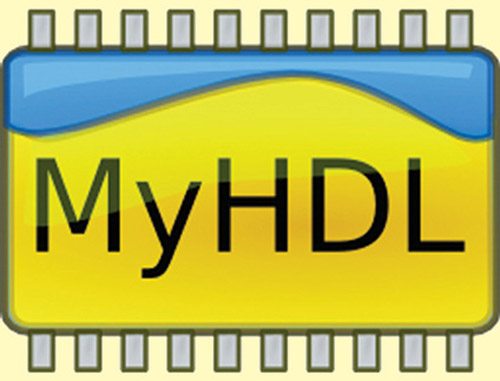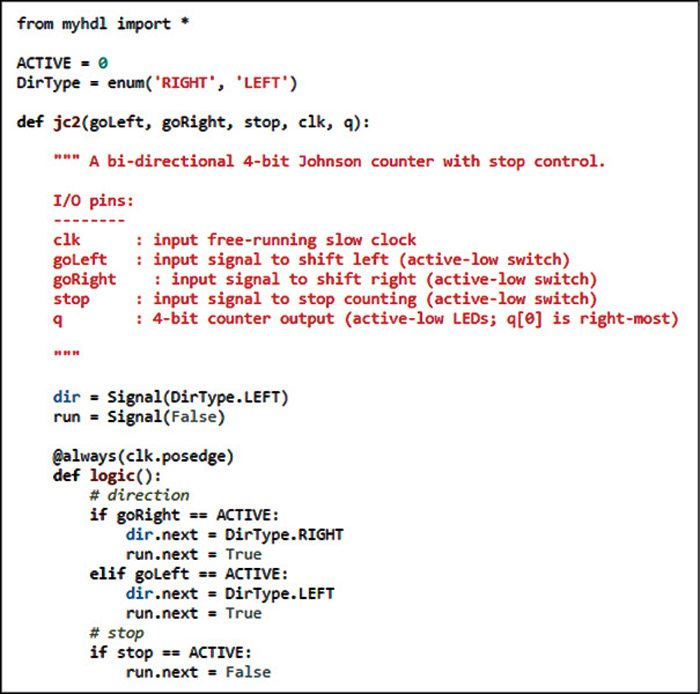 Conventionally, the design of digital hardware systems is done using a specialised hardware description language (HDL), like VHDL and Verilog. This selection is based on the idea that hardware design has its own unique requirements.
Conventionally, the design of digital hardware systems is done using a specialised hardware description language (HDL), like VHDL and Verilog. This selection is based on the idea that hardware design has its own unique requirements.
MyHDL is an open source platform developed by Jan Decaluwe for using Python, a general-purpose high-level language for hardware design. A designer using this software can benefit from the power of Python language as well as the merits of a free, open source software.
The software can be installed on any platform that supports Python. The installation guide for MyHDL on a typical Linux or Unix system is present on MyHDL official website. Non-Linux platforms, like Windows, also have a similar installation procedure.
Key functionalities of the tool
The main vision behind developing this open source tool is to empower hardware engineers with the power, clarity and simplicity of Python. Let us take a look at the main functions of this software in detail.
High-level modelling. Python is a very high-level language, famous for giving elegant solutions to complex modelling problems. Apart from this, the ability of Python of rapid application development and experimentation is outstanding. All these features of MyHDL make it an ideal solution for hardware modelling.

In order to model hardware concurrency, MyHDL makes use of Python generators. Generators used in MyHDL resemble the Always blocks in Verilog and processes in VHDL. The software models a hardware module as a function that returns generators. A wide range of features, such as arbitrary hierarchy, named-port association, arrays of instances and conditional instantiation, can be easily supported because of this straightforward approach. Classes in MyHDL support traditional hardware description concepts. There is a signal class to support communication between generators, a class to support bit-oriented operations and a class for enumeration types.
Converting the design to Verilog and VHDL. Although there are some limitations, designs in MyHDL can be converted into Verilog or VHDL. Of course, the convertible subset is restricted. But it is much wider than the standard synthesis subset. It includes features that can be used for high-level modelling and test benches. Also, conversion limitations are only applicable for the code inside the generators. Python’s full power can be used without compromising convertibility outside the generators. The conversion provides a path into the traditional design flow, including synthesis and implementation.
A number of complex tasks in VHDL and Verilog, such as handling of signed arithmetic issues, can be directly automated with the help of the converter in MyHDL. The converter works on a fully-elaborate, instantiated design. As a result, the original design structure can be arbitrarily complex.
Simulation and verification functions. MyHDL has a built-in simulator that runs on top of the Python interpreter, which supports waveform viewing. Tracing the changes of the signal in a VCD file enables viewing of the waveform. The software enables the Python unit test framework to be used in hardware designs.
Unit testing is a very popular verification technique in modern software engineering. But when it comes to a hardware platform, testing is not that common. In case of Verilog designs, we can also use MyHDL as hardware verification language by co-simulation with traditional HDL simulators.
How MyHDL benefits users
In this section let us try to analyse some of the reasons why a hardware designer should consider MyHDL tool.
For beginners
Free and open source. As a beginner, you will be least interested in purchasing a costly software. MyHDL is a well-documented, open source software that a beginner can really benefit from.

Simplicity of Python. An engineer trying to master digital hardware design needs to put up a lot of hard work. Choice of a right developing language makes his or her task easier. Among high-level programming languages, Python is one of the simplest to learn, and MyHDL aims to bring the same level of simplicity into hardware design.
Apart from this, the automated conversion of design into Verilog/VHDL also eases the job of a designer as a beginner.
For professionals
Latest software developments readily available for the designer. Many developments are going on in software methodologies which lead to major improvements in the development process. These are emerging in communities of modern software languages, like Python.
As MyHDL is based on Python language, these developments are directly available to the hardware designer. An example is that of unit testing, previously mentioned in this article.
Use of dynamic language directly for hardware design. Dynamic languages, like Python, Perl and Tcl, play an important role in modern digital designs. Many developers prefer these languages to HDL languages, because they can get things done quickly with these. Again, MyHDL has significant advantage over other HDL languages as it uses a dynamic language (Python) directly to design hardware.








How do we install co-simulation support for myHDL in python? The documentation isn’t very clear in this regard. Can you please provide some help on this?